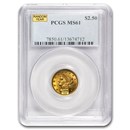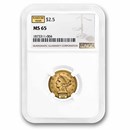$2.50 Liberty Quarter Eagles
The $2.50 Liberty Quarter Eagle is a gold coin that was minted by the United States from 1840 to 1907. It contains 0.12094 troy ounces of gold and has a face value of $2.50. The coin gets its name from the image of Lady Liberty on the obverse (front) side of the coin.
These smaller denomination coins circulated widely throughout the United States in the days when they were commonly used as currency. Created by Christian Gobrecht, the Liberty Quarter Eagle’s design remained unchanged for 67 years, longer than any other design in the history of American gold coinage.
Liberty Quarter Eagle Design
The obverse side features a left-facing image of Lady Liberty, wearing a coronet inscribed with the word "LIBERTY." She is surrounded by thirteen stars, representing the original thirteen colonies of the United States. The reverse side features an eagle with outstretched wings, holding arrows and an olive branch, symbolizing both war and peace.
The $2.50 Liberty Quarter Eagle was designed by Christian Gobrecht, who also designed other U.S. coins such as the Seated Liberty and the Flying Eagle cent. The coins were minted at several different U.S. mints, including Philadelphia, San Francisco, and New Orleans.
The $2.50 Liberty Quarter Eagle is a popular coin among collectors and investors due to its historical significance, relatively low mintage numbers, and the fact that it contains a small amount of gold, which makes it more accessible for many collectors and investors.
The Influence of Christian Gobrecht
Christian Gobrecht was a prominent American engraver and designer who worked for the United States Mint from 1835 to 1844. He is best known for his design of the Seated Liberty coin series and the $2.50 Gold Liberty Quarter Eagle.
In 1839, the United States Mint decided to replace the existing design of the $2.50 Gold Quarter Eagle with a new design that would feature a more prominent image of Lady Liberty. Gobrecht was tasked with creating the new design, and he came up with the classic design we see today.
On the reverse side of the coin, Gobrecht designed an eagle with outstretched wings holding an olive branch and arrows, surrounded by a wreath. The design was first used on the $10 Gold Eagle in 1838 and was later adapted for use on the $2.50 Gold Quarter Eagle in 1840.
Executive Order 6102: The Importance of Pre-1933 Gold
The $2.50 Gold Liberty Quarter Eagle quickly became popular among collectors and investors due to its small size and relative affordability. It was minted from 1840 to 1907, with production ceasing when the United States moved away from the gold standard.
Executive Order 6102, which was signed by President Franklin D. Roosevelt on April 5, 1933, recalled gold coins, bullion, and certificates from circulation and required individuals to turn in their gold to the Federal Reserve in exchange for paper currency.
The purpose of the executive order was to combat the Great Depression, which had severely affected the United States economy. At the time, the United States was still on the gold standard, which meant that the value of the U.S. dollar was tied to the value of gold. The government hoped that by recalling gold from circulation, it could increase the money supply and stimulate economic growth.
Under Executive Order 6102, individuals were required to turn in all gold coins, bullion, and certificates to the Federal Reserve by May 1, 1933. Those who failed to comply with the order could be fined up to $10,000 (equivalent to over $200,000 in today's currency) or face up to 10 years in prison.
The executive order effectively ended the circulation of gold coins in the United States and led to the creation of the Gold Reserve Act of 1934, which devalued the dollar in relation to gold and allowed the government to hold more gold reserves.
The recall of gold under Executive Order 6102 remains controversial to this day, with some arguing that it violated individual property rights and others arguing that it was necessary to combat the economic crisis of the time.
The Historical Significance of Liberty Quarter Eagles
Liberty Quarter Eagles were used as currency before President Franklin Roosevelt required Americans to turn in their gold coins to be melted into bars to help combat the Great Depression. The recall of gold made these coins a rare find. Now, the surviving coins are sought after by collectors and investors alike as one of many Pre-33 gold coin options.
Today, the $2.50 Gold Liberty Quarter Eagle is a popular choice among collectors and investors who appreciate its historical significance and the fact that it contains a small amount of gold, making it more accessible for many people.























































